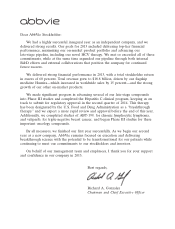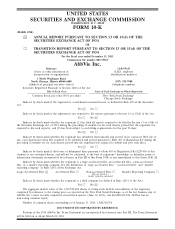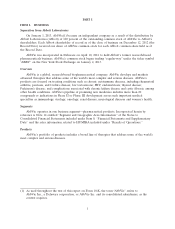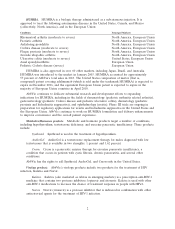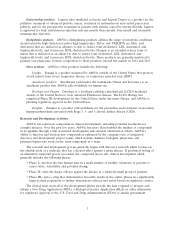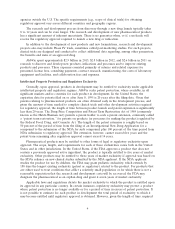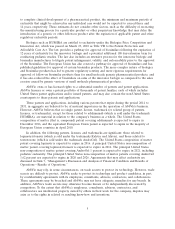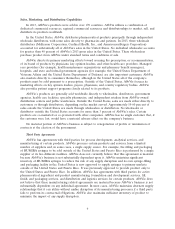AbbVie 2013 Annual Report Download - page 12
Download and view the complete annual report
Please find page 12 of the 2013 AbbVie annual report below. You can navigate through the pages in the report by either clicking on the pages listed below, or by using the keyword search tool below to find specific information within the annual report.treatment of many diseases, including some for which therapies were unavailable or inadequate. The
advent of biologics has also raised complex regulatory issues and significant pharmacoeconomic
concerns because the cost of developing and producing biologic therapies is typically dramatically
higher than for conventional (small molecule) medications, and because many expensive biologic
medications are used for ongoing treatment of chronic diseases, such as rheumatoid arthritis or
inflammatory bowel disease, or for the treatment of previously untreatable cancer. Significant
investments in biologics infrastructure and manufacturing are necessary to produce biologic products, as
are significant investments in marketing, distribution, and sales organization activities, which may limit
the number of biosimilar competitors.
In the United States, the FDA regulates biologics under the Federal Food, Drug, and Cosmetic
Act, the Public Health Service Act, and implementing regulations. While the enactment of federal
health care reform legislation in March 2010 was meant to provide a pathway for approval of
biosimilars under the Public Health Service Act, recent regulatory guidance suggests that the approval
process for biosimilars will be far more extensive than the approval process for generic or other
follow-on versions of small molecule products, in order to ensure that the safety and efficacy of
biosimilars is highly similar to that of an original biologic, such as HUMIRA. Ultimate approval by the
FDA is dependent upon many factors, including a showing that the biosimilar is ‘‘highly similar’’ to the
original product and has no clinically meaningful differences from the original product in terms of
safety, purity, and potency. The types of data that could ordinarily be required in an application to
show similarity would include analytical data and studies to demonstrate chemical similarity, animal
studies (including toxicity studies), and clinical studies. Applicable regulations also require that the
biosimilar must be for the same indication as the original biologic and involve the same mechanism of
action, and that the manufacturing facility meets the standards necessary to assure that the biosimilar is
safe, pure, and potent.
Furthermore, the new law provides that only a biosimilar product that is deemed to be
‘‘interchangeable’’ may be substituted for the original biologic product without the intervention of the
health care provider who prescribed the original biologic product. To prove that a biosimilar product is
interchangeable, the applicant must demonstrate that the product can be expected to produce the same
clinical results as the original biologic product in any given patient, and if the product is administered
more than once in a patient, that safety risks and potential for diminished efficacy of alternating or
switching between the use of the interchangeable biosimilar biologic product and the original biologic
product is no greater than the risk of using the original biologic product without switching. The new
law is only beginning to be interpreted and implemented by the FDA. As a result, its ultimate impact,
implementation, and meaning will likely be subject to substantial uncertainty for years to come.
In the European Union, while a pathway for the approval of biosimilars has existed since 2005, the
products that have come to market to date have had a mixed impact on the market share of incumbent
products, with significant variation by product.
Other Competitive Products. Although a number of competitive biologic branded products have
been approved since HUMIRA was first introduced in 2003, most have gained only a modest share of
the worldwide market. In addition, the first JAK inhibitor, part of a new class of orally administered
products, was recently approved for use in rheumatoid arthritis in the U.S. AbbVie will continue to
face competitive pressure from these biologics and orally administered products.
Regulation—Discovery and Clinical Development
United States. Securing approval to market a new pharmaceutical product in the United States
requires substantial effort and financial resources and takes several years to complete. The applicant
must complete preclinical tests, and obtain FDA approval before commencing clinical trials. Clinical
trials are intended to establish the safety and efficacy of the pharmaceutical product and typically are
8



